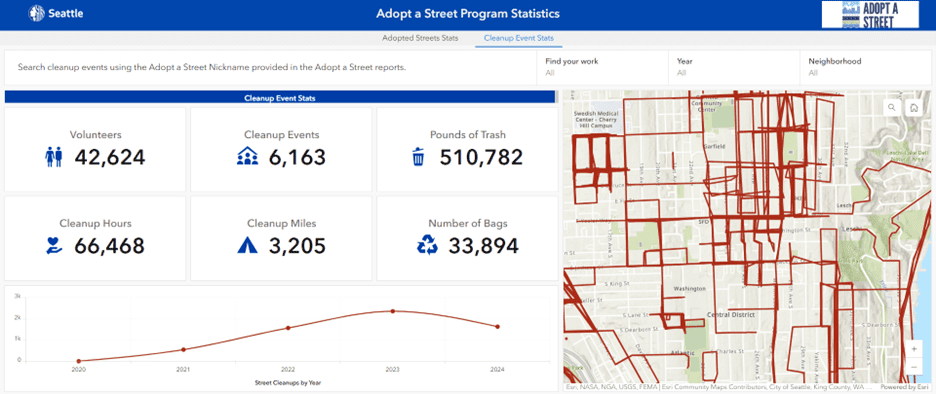Adopt-A-Street. You might have seen the name before, but what is it, really? The answer is simple: Adopt-A-Street is a community-centered program that helps Seattle residents keep their neighborhood streets clean by empowering volunteers to sign up online. The program is administered by Seattle Public Utilities (SPU), but behind the scenes, it is tech that makes Adopt-A-Street tick. Recent additions from Seattle IT to Adopt-A-Street’s tech stack have made the program more engaging than ever.
The Adopt-A-Street pages on Seattle.gov have recently been updated to include a GIS (geographic information system)-based dashboard for anyone to view statistics on the number of clean-up events happening, the number of pounds of trash collected, the number of miles adopted by neighbors, and more. In addition to the dashboard, the site now includes a volunteer sign-up form, graffiti clean-up forms, supply request forms, and language translations.

We sat down Seattle IT’s GIS team and SPU’s Jenny Frankl to discuss the new updates and plans for Adopt-A-Street’s future.
Seattle IT GIS Analyst John Edwards helped to implement the new forms for sign-ups and reports, a new public dashboard, and a back-end administration page using geographical data. Edwards shared two key points with us. One: the new public dashboard is interactive, which allows you to search and filter the work you have done for street adoptions and clean-up events by who, where, and when you did it. Two: the newly updated administration webpage allows the SPU staff to quickly approve requests, make corrections, and run reports on the work being done so that they can better serve the public.
SPU Senior Planning and Development Specialist Jenny Frankl oversees the business side of Adopt-A-Street and shared with us her team’s excitement and appreciation for the recent updates and some future updates their team hopes to have implemented.
According to Frankl, the new updates allowed their team at SPU to get rid of the three-day delay in volunteer sign-ups thanks to speeding up data entry tasks using the new forms and administrative webpages. The updates ensured there would be no double entries that needed to be rechecked, overall speeding up the process.
“A few more ‘someday’ hopes would be to have an Adopt a Street mobile app created (right now it is just a webpage); a way for volunteers to indicate that they cleaned their adopted streets instead of having to draw their line each time; some built-in communication that we can send to volunteers when we haven’t heard from them for a period of time to ensure they are still active with the program; and greater cohesion/coordination with the Find It, Fix It app,” said Frankl.
Frankl has this to say about Adopt-A-Street: “It’s easy to be a part of a rewarding and fun way to make a difference in Seattle! Everyone does Adopt a Street in their own unique way, and that is a beautiful thing.”